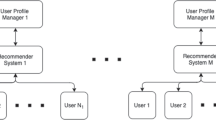Abstract
Since e-catalogs are dynamic, autonomous, and heterogeneous, the integration of a potentially large number of dynamic e-catalogs is a delicate and time-consuming task. In this paper, we describe the design and the implementation of a system through which existing on-line product catalogs can be integrated, and the resulting integrated catalogs can be continuously adapted and personalized within a dynamic environment. The integration framework originates from a previous project on integration of Web data, called WebFINDIT. Using the framework, we propose a methodology for adaptation of integrated catalogs based on the observation of customers' interaction patterns.
Similar content being viewed by others
References
C. C. Aggarwal and P. S. Yu, “Data mining techniques for personalization,” Bulletin of the Technical Committee on Data Engineering23(1), March 2000.
Ariba Inc., http://www.ariba.com
B. Benatallah, M. Dumas, Q. Z. Sheng, and A. H. H. Ngu, “Declarative composition and peer-to-peer provisioning of dynamic Web services,” in Proceedings of the International Conference on Data Engineering, San Jose, USA, February 2002.
B. Berendt and M. Spiliopoulou, “Analysing navigation behaviour in Web sites integrating multiple information systems,” VLDB Journal, Special Issue on Databases and the Web 9(1), 2000, 56–75.
J. Borges and M. Levene, “Data mining of user navigation patterns,” in Proceedings of the Workshop on Web Usage Analysis and User Profiling (WEBKDD'99), San Diego, CA, August 1999.
A. Bouguettaya, B. Benatallah, and A. K. Elmagarmid, Interconnecting Heterogeneous Information Systems, Kluwer Academic, Boston, 1998.
A. Bouguettaya, B. Benatallah, L. Hendra, M. Ouzzani, and J. Beard, “Supporting dynamic interactions among Web-based information sources,” IEEE Transactions on Knowledge and Data Engineering12(5), September/October 2000, 779–801.
commerceOne Inc., http://www.commerceone.com
R. Cooley, B. Mobasher, and J. Srivastava, “Data preparation for mining World Wide Web browsing patterns,” Journal of Knowledge and Information Systems1(1), 1999.
A. Datta, K. Dutta, D. E. VanderMeer, K. Ramamritham, and S. B. Navathe, “An architecture to support scalable online personalization on the Web,” VLDB Journal10(1), 2001, 104–117.
Dublin Core Metadata Initiative (DCMI), http://www.dublincore.org
D. Fensel, Y. Ding, and B. Omelayenko, “Product data integration in B2B e-commerce,” IEEE Intelligent Systems16(4), July/August 2001.
J. Jung, D. Kim, S. Lee, C. Wu, and K. Kim, “EE-Cat: Extended electronic catalog for dynamic and flexible electronic commerce,” in Proceedings of the IRMA2000 International Conference, Anchorage, AK, IDEA Group Publishing, May 2000.
J. A. Konstan, B. N. Miller, and D. Maltz, “GroupLens: Applying collaborative filtering to Usenet news,” Communications of the ACM40(3), March 1997.
D. Mladenic, “Text-learning and related intelligent agents: A survey,” IEEE Intelligent Systems14(4), July/August 1999, 44–54.
B. Mobasher, R. Cooley, and J. Srivastava, “Automatic personalization based on Web usage mining,” Communications of the ACM43(8), August 2000.
G. Modica, A. Gal, and H. M. Jamil, “The use of machine-generated ontologies in dynamic information seeking,” in Proceedings of Sixth International Conference on Cooperative Information Systems (CoopIS 2001), Trento, Italy, 2001.
T. Nakayma, H. Kato, and Y. Yamane, “Discovering the gap between Web site designers' expectations and user's behaviour,” in Proceedings of 9th International World Wide Web Conference, Amsterdam, May 2000.
S. Navathe, H. Thomas, M. Satits, and A. Datta, “A model to support e-catalog integration,” in Proceedings of the IFIP Conference on Database Semantics, Hong Kong, Kluwer Academic, April 2001.
H. Paik, B. Benatallah, and R. Hamadi, “Usage-centric adaptation of dynamic e-catalogs,” in Proceedings of 14th International Conference on Advanced Information Systems Engineering, Toronto, Canada, May 2002.
M. Perkowitz and O. Etzioni, “Adaptive Web sites,” Communications of the ACM43(8), August 2000.
M. Perkowitz and O. Etzioni, “Towards adaptive Web sites: Conceptual framework and case study,” Artificial Intelligence118, 2000, 245–275.
R. Sadri, C. Zaniolo, A. Zarkesh, and J. Adibi, “A sequential pattern query language for supporing instant data mining for e-services,” in Proceedings of the 27th VLDB Conference, Roma, Italy, September 2001.
M. Spilopoulou, “Web usage mining for Web site evaluation,” Communications of the ACM43(8), August 2000.
R. Srikant and Y. Yang, “Mining Web logs to improve website organization,” in Proceedings of 10th International World Wide Web Conference, Hong Kong, May 2001.
M. Toyoda and M. Kitsuregawa, “A Web community chart for navigating related communities,” in Proceedings of 10th International WWW Conference, Hong Kong, May 2001.
K. Wu, C. C. Aggarwal, and P. S. Yu, “Personalization with dynamic profiler,” Technical Report, IBM Research Division, T. J. Watson Research Center, Yorktown Heights, NY, 2001.
XML Common Business Library, http://www.xcbl.org
G. Yan, W. Ng, and E. Lim, “Product schema integration for electronic commerce – A synonym comparison approach,” IEEE Transactions on Knowledge and Data Engineering14(3), May/June 2002.
D. Yang, W. Sung, S. Yiu, D. Cheung, and W. Ho, “Construction of online catalog topologies using decision trees,” in Proceedings of Second International Workshop on Advance Issues of E-Commerce and Web-Based Information Systems (WECWIS 2000), Milpitas, CA, 8–9 June 2000.
Author information
Authors and Affiliations
Rights and permissions
About this article
Cite this article
Paik, HY., Benatallah, B. & Hamadi, R. Dynamic Restructuring of E-Catalog Communities Based on User Interaction Patterns. World Wide Web 5, 325–366 (2002). https://doi.org/10.1023/A:1021072310244
Issue Date:
DOI: https://doi.org/10.1023/A:1021072310244




